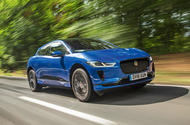The Jaguar I-Pace is currently the only electric car JLR produces
JLR owners will spend £4 billion to build 40GWh plant, with production to start from 2026
Tata Sons battery company Agratas will own the intellectual property on batteries made at its new plant in Somerset and it intends to offer them to other companies besides Jaguar Land Rover (JLR) and Tata Motors, the company has said.
The JLR owner announced on Wednesday it will spend £4 billion to build a 40GWh plant in the West Country, with production set to start from 2026.
The big question surrounding the investment – after the location – had concerned the ownership of the cell chemistry, but Tata has now said the formula will be owned by Agratas itself, the new Tata battery company set up to build batteries both in Somerset and in a previously announced plant to be built in Gujarat, India.
“Agratas is an IP-heavy and capital-heavy company,” Pathamadai Balaji, chief financial officer of Tata Motors, said at the company investor day held at JLR’s HQ at Gaydon in June. “And in this, the role of JLR and Tata Motors is one of an anchor customer, not a 100% customer. Agratas is not intended to supply only to these two companies.”
The gigafactory will make cells in the rectangular ‘prismatic’ format rather than the cylindrical shape as preferred by Tesla and BMW. Within that, the cell chemistry can be adapted and changed as new advancements are made. “The prismatic format as a prismatic is currently fixed, but inside it, we could do any chemistry needed, including solid state,” Balaji said, referring to the promising but as yet unscaled-up chemistry that would increase range and cut charging time.
The danger of relying on Agratas for cells is that JLR would be locked into one supplier without being able to shop around for cheaper or more advanced chemistries. However, Balaji dismissed this concern, raised by one of the attending bankers, and flipped it around. “The market has changed dramatically today,” he said. “If you want the kind of investment that JLR is looking at in [batteries], it is pay-to-play. You’re spending a humongous amount of cash without any return on the IP and without any return on the relationship that we’re trying to build here.”
Balaji said the Agratas/JLR relationship “places us very, significantly better than most other OEMs.”
JLR will pay its share of helping develop and industrialise the batteries. “As an anchor customer, we will need to take the burden of some those investment costs, which we will do so,” JLR acting chief financial officer Richard Molyneux said at the analyst day.
The battery packs from Agratas are significantly more energy dense than those supplied by LG Chem for the Jaguar I-Pace, currently JLR’s only electric car. The new batteries would give 120kWh from 342 litres of cell capacity, compared with 84kWh from 387 litres in the I-Pace pack, Thomas Mueller, JLR head of product engineering, told investors.
“You see the numbers: we managed to almost double the range that the customer will get in less volume,” Mueller said “It’s impossible to do that if you don’t have Agratas co-developing with you the technology.”
The pack size would give a range of up to 450 miles in the EMA Ultra Range pack, Mueller said. EMA is the new electric architecture that will underpin smaller Range Rover, Discovery and Defender models in the future.
The battery would also allow fast charging, adding an extra 200 miles in 15 minutes, Mueller said.
JLR will launch an electric Range Rover next year, followed by three electric Jaguars, with a “four-door GT” arriving first in 2025.
The broader industrial Tata Group has an existing interest in batteries via the Material Sciences and Energy Sciences arm of Tata Chemicals. The division website says the company is “partnering with leading battery makers in the world for contemporary commercial cells”, suggesting it has previously worked with outside cell companies, although it also highlighted its own “global R&D labs for next-generation technologies”.
Source: Autocar
